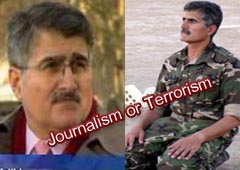He was wearing a military uniform, sitting on his knees. This was the first picture I saw of Ali Safavi after I was keenly aroused to know him and his agenda. I had noticed his name as the  author of an article in favor of Mujahedin Khalq Organization (MKO/MEK/PMOI) some years ago. After a quick Google search, I came across with his photograph in military uniform. Another photo portrayed him in a visit between Maryam Rajavi and the Israeli Rabbi Daniel Zucker.
author of an article in favor of Mujahedin Khalq Organization (MKO/MEK/PMOI) some years ago. After a quick Google search, I came across with his photograph in military uniform. Another photo portrayed him in a visit between Maryam Rajavi and the Israeli Rabbi Daniel Zucker.
Shockingly, on the Huffington Post, Safavi is introduced as a member of Iran’s parliament in Exile which is the elegant, polished title for NCR. According to the US State Department NCR is an alias for the MKO, thereby it is a terrorist organization –the State Department added NCR to the list in 1999. [1] Only the fact that Safavi is a member of a terrorist designated organization, writing on a professional media leads to the idea of shady journalism which is manipulating the ignorant audience.
How Safavi uses shady journalism to meaningfully distract public opinion? What are his rhetorical strategies to thrust his poorly stated ideas on the readers?
His sophistical arguments help Safavi convince people to think in unethical ways or draw false conclusion. The NCR member uses quibbling arguments to deceive his intended audience as what the first teachers of the history, the Sophists did.
As it was analytically described in the first part of these articles, “Repetition” is the very tool Safavi exploits to promote his cause – let’s say the cause of terrorist designated Mujahedin Khalq Organization. This major rhetorical strategy is used to produce emphasis, magnification and sometime moving effect.
The use of several synonymous or parallel words together and in various intervals helps him amplify his argument. For instance, the company of Iranian “regime” with “execution” in more than 50 cases implies what Safavi is strongly determined to do: demonizing Islamic Republic.
Repeating the name of MKO and its aliases for over 340 times, Safavi dwells on or returns to his strongest argument which is to promote MKO in Washington and its removal from the list of FTOs of the State Department. He gives excessive coverage to the group, its leaders and its activities. He exaggerates about their achievements. For instance, as I mentioned before, he describes MKO as the main Iranian opposition for over twenty times – although the group has no significant popular support inside Iran according to the recent unclassified report ” IRANIAN POPULAR ATTITUDES TOWARDS THE MEK" published in May 2011. The cable was based on input from State Department Iran-watchers and consular interviewing officers in the main posts that interact with Iranians on a regular basis. [2]
By going over a word or phrase like “democracy “or “democratic change” for about 40 times, in different parts of his writings, he pushes the audience to recognize fake importance of the MKO agenda. He portrays the Rajavis as heroes to bring "democratic change" by giving them extraordinary attention. However, the Rajavis are hardly ever known by the Iranian majority. "In speaking to hundreds of Iranians both in the preceding two months and before, ordinary Iranians were almost uniformly dismissive of the MEK, reacting with either disdain or apathy", according to the report.[3]
Ali Safavi vigorously pushes for on his partial allegation that his organization was blacklisted as a terrorist entity by Clinton administration as ”a good will gesture" to IRI, in almost all of his articles, although MKO was listed as a terror group at least three years prior to 1997. The DOS’s fourteen-page report on the group was published in 1994. [4]
Calling MKO opponents as “Tehran apologists” or “Intelligence agents” in a variety of cases, suggests that Safavi‘s unethical journalism is never free from bias. According to him, anyone who disagrees with the MKO deserves to be called Iranian “lobbyist” or “ agent “ but his own biased journalism to boost a terrorist designated group is professional! His most recent reaction[5] against Michael Rubin’s Commentary[6] is a significant evidence for my assertion.
The few mentioned examples of Safavi’s subtle and often unsound reasoning and his irresponsible coverage of a terrorist designated group poses a question in our mind: How can a journalist promote, encourage and endorse the cause of terrorists? His malpractices in support of a terrorist destructive cult prove his shady_ if not dirty_ journalism. That’s when journalism becomes a tool to advocate terrorism.
By Mazda Parsi
References:
[1]US Department of State, Country Report on Terrorism 2006
http://www.state.gov/s/ct/rls/crt/2006/82738.htm
[2] U.S. State Department document released in May 2011 under the U.S. Freedom of Information Act http://iran.org/news/2010_05_25-10MEKdocs-DOC10.pdf
[3]ibid
[4]U.S. Department of State, Patterns on Global Terrorism. The 1994 report http://www.fas.org/irp/threat/terror_94/append.html
[5] Nejat bloggers are either former MKO members or have a family member who is currently held in Camp Ashraf. They have suffered deeply because of Massoud Rajavi’s crimes. While the Nejat Bloggers recognize that citing sources of information is essential ,we, as a society feel so strongly against the MKO that we have agreed to not include the group’s websites or links in our articles because we consider it as kind of publicity for the cult.
[6] Rubin, Michael, Bachmann and the Mujahideen–e-khalq, Commentary Magazine, July 3,2011
http://www.commentarymagazine.com/2011/07/03/michele-bachmann-and-the-mujahideen-e-khalq/

